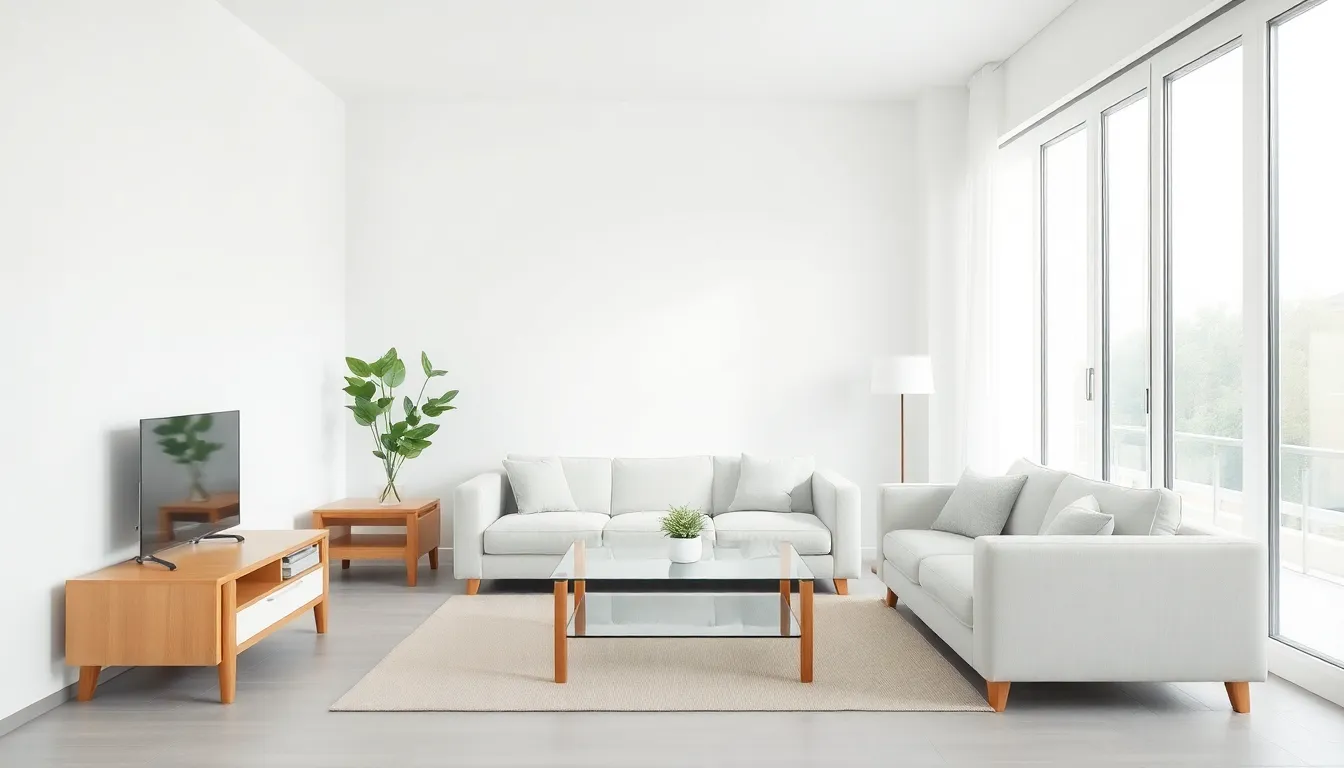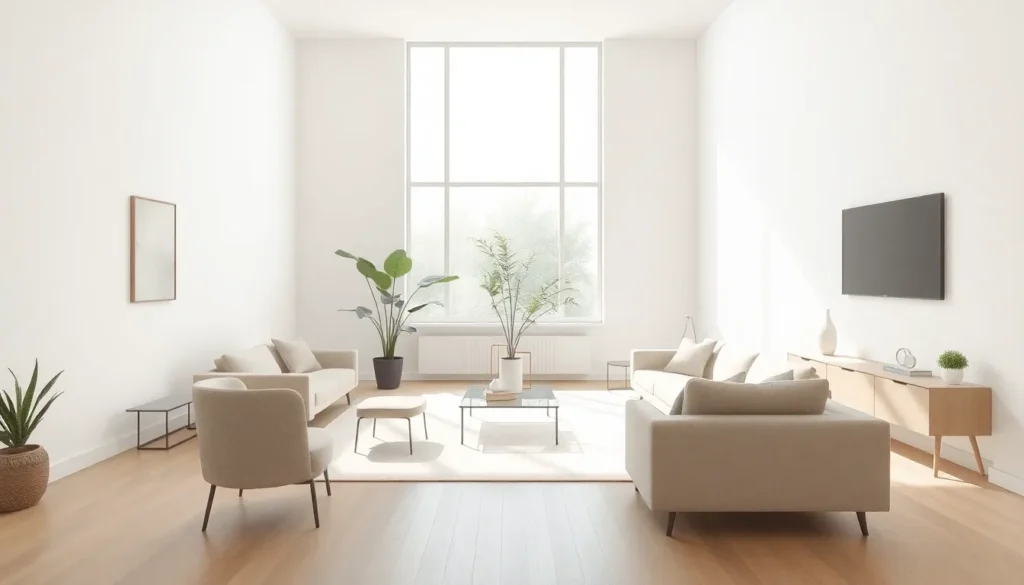In a world overflowing with clutter and chaos, the minimalist interior design trend emerges like a breath of fresh air. Imagine a living room where every piece of furniture serves a purpose and every decorative item sparks joy—sounds dreamy, right? Minimalism isn’t just about less; it’s about creating a serene space that invites relaxation and clarity, all while making your friends wonder if you’ve secretly become a design guru.
Table of Contents
ToggleWhat Is Minimalist Interior Design?
Minimalist interior design prioritizes simplicity and functionality. This design ethos emphasizes a less-is-more approach, focusing on essential elements that serve a purpose. Clean lines, neutral colors, and uncluttered spaces characterize this style, creating a serene environment.
Strategically choosing furniture and decor plays a crucial role. Each item must contribute to the space’s overall design and function. Natural light often enhances minimalist interiors, providing warmth and openness, which further promotes relaxation.
An important aspect is the use of materials. Opting for high-quality, timeless materials adds elegance without overwhelming the senses. Wood, glass, and metal frequently appear in minimalist designs, balancing aesthetics and practicality.
Color palettes generally remain muted, incorporating whites, grays, and earth tones. These hues create visual harmony and allow for a more spacious feel. Patterns usually stay minimal or entirely absent, ensuring that each component retains focus.
Employing negative space fosters a sense of calm. It shifts attention to the few carefully selected furnishings or decor pieces, creating a visual balance. Personalized decor items can accentuate character without disrupting the minimalist ethos.
Functionality drives layout decisions. Spaces often adapt to various activities while maintaining an airy feel. Ensuring smooth traffic flow and easy access to essential areas supports a practical, livable environment.
Key Elements of Minimalist Interior Design Living Room

Minimalist interior design thrives on clarity and simplicity, focusing on essential elements that create inviting spaces. Key components contribute to this aesthetic, ensuring each aspect enhances the overall atmosphere.
Color Palette
Color choices significantly impact a minimalist living room. Neutral tones such as whites, grays, and soft earth shades dominate this style. These colors promote a sense of calm and spaciousness, enhancing the serenity that minimalism embodies. Subtle contrasts can arise through variations in hue, but loud colors are typically avoided. A carefully curated palette encourages visual harmony and maintains an uncluttered look.
Furniture Selection
Furniture selection plays a vital role in minimalist living room design. Functional pieces with clean lines and simple forms take precedence. Each item should serve a specific purpose without overwhelming the space. Wood, glass, and metals often form the foundation of furniture choices, providing durability and timeless appeal. Arranging furniture promotes openness and flow, allowing movement while creating a breathable environment.
Accessories and Decor
Accessories and decor highlight the essence of minimalism in the living room. Thoughtfully selected items provide personal touches without creating clutter. Artworks typically feature minimalistic designs, avoiding busy patterns that distract from the overall look. Plants can introduce a touch of nature, enhancing warmth and vitality. By emphasizing negative space, decor choices draw attention to carefully chosen elements that reflect individual style.
Tips for Achieving a Minimalist Look
Achieving a minimalist look in the living room requires careful consideration of various elements. Start with decluttering, as this forms the foundation of minimalism. Reduce belongings by evaluating every item, keeping only those that serve a purpose or hold significant meaning. Limit decorative pieces to a select few, ensuring each has a place. Organizing items in dedicated storage will maintain an uncluttered aesthetic.
Focus on functional furniture to enhance simplicity. Choose pieces that feature clean lines and muted colors, promoting an unassuming ambiance. Multipurpose items such as ottomans that serve both seating and storage add value without contributing to clutter. Choose low-profile sofas or chairs that maintain visual openness throughout the room.
Creating open spaces plays a vital role in achieving a minimalist design. Arrange furniture to maximize flow, allowing easy movement between different areas. Keep pathways clear, preventing congestion and fostering a sense of airiness. Utilize large rugs to define spaces while retaining an overall uncluttered look. Prioritizing negative space ensures that essential elements stand out and contribute to the calming atmosphere.
Benefits of Minimalist Interior Design Living Room
Minimalist interior design in the living room offers numerous advantages. One significant benefit involves promoting tranquility. Simple spaces encourage relaxation and reduce stress, creating an inviting atmosphere for both residents and guests.
Increased functionality is another key benefit. By emphasizing essential furniture and decor, this design style ensures that every item serves a purpose. Multifunctional pieces, such as ottomans with storage or sleek coffee tables, maximize utility while maintaining a clean aesthetic.
Visual spaciousness is also an important factor. Neutral colors and uncluttered surfaces create the illusion of a larger area, making even small living rooms feel airy and expansive. Natural light further enhances this effect, allowing for bright, welcoming spaces.
Maintenance demands decrease in minimalist spaces. Fewer objects mean less dusting and cleaning, allowing individuals to spend more time enjoying their environment. This convenience contributes to a more organized and hassle-free lifestyle.
Clarity of design stands out within minimalist interiors. With intentional choices for furniture and decor, the overall look remains cohesive. This harmony fosters a sense of serenity, making the living room a favorite spot for relaxation and socializing.
Creativity gets a boost in minimalist settings as well. Freed from excessive clutter, individuals can focus on the thoughtfully chosen pieces that truly reflect personal style. This emphasis on quality over quantity leads to a more meaningful and personalized space.
Lastly, a minimalist living room often impresses visitors. A well-executed design demonstrates sophistication and attention to detail, enhancing the homeowner’s reputation for thoughtful living.
Embracing minimalist interior design in the living room transforms not just the space but also the atmosphere within it. By prioritizing simplicity and functionality, individuals can create a serene environment that fosters relaxation and clarity. Thoughtful selections of furniture and decor enhance both aesthetics and utility, while neutral color palettes promote a sense of spaciousness.
This design approach encourages a lifestyle free from clutter and distractions, making the living room a perfect sanctuary for unwinding or entertaining. Ultimately, minimalist interiors reflect a commitment to quality and intentionality, allowing personal style to shine through in a harmonious setting. Adopting this trend can truly elevate any living space, creating a lasting impression on all who enter.



